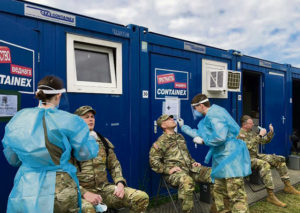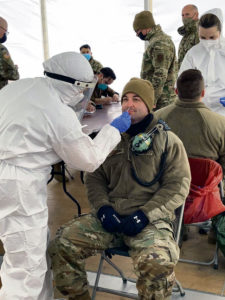
Global response to the COVID-19 pandemic has been plagued by chaos. National border and travel restrictions constantly change. New strains of the virus emerge. Infection rates wax and wane. From Argentina to China, handwashing, mask wearing and social distancing practices vary.
Imagine the battle plan needed to combat the threat of COVID-19 during a multinational military exercise involving more than 28,000 forces from 26 nations across more than a dozen countries.
Fortunately, U.S. Army Europe and Africa and 21st Theater Sustainment Command has the knowledge, experience and esprit de corps needed to protect health and safety during DEFENDER-Europe 21 — the large-scale U.S. Army-led exercise designed to build readiness and interoperability between the U.S., NATO allies and partner militaries taking place through June.
“The COVID mitigation effort for Defender 21 was truly a full Army across Europe endeavor,” said Maj. Mark Moore, Plans Officer for the 21st TSC Distribution Integration Branch. “Starting at Army Europe level and then down to brigade. These folks were instrumental in planning, coordinating, and executing this very complex and ever changing plan. Without them and so many unnamed personnel, we would not have been successful and getting this off the ground.”
Prevent, detect and treat
Three pillars of the DEFENDER-Europe 21 COVID mitigation strategy are to prevent, detect and treat. Essential to operationalizing those pillars is a network of COVID support sites and isolation facilities. Located throughout the European theater, these sites provide personal protective equipment, hygiene supplies, testing, and isolation facilities staffed with a COVID support team.
Months of planning went in to establishing sites in Albania, Bosnia, Bulgaria, Croatia, Estonia, Greece, Hungary, Kosovo, Lithuania, North Macedonia and Romania.
Led by the 21st TSC Distribution Management Center DIB, a team of logistics professionals made sure the sites were well-stocked with Class II (personal protective equipment, hygiene products, etc.) and Class VIII (medical supplies including pharmaceuticals) materials. Thousands of units of gloves, gowns, testing materials, ventilators, respirators, sanitizers and medical waste supplies were just a few of the items needed.
Capt. Josh Dillard, 30th Medical Brigade deputy officer in charge of logistics, says transporting medical supplies over international borders during a pandemic presented unique challenges. In addition to timeline constraints dictated by the exercise schedule, participating countries had different COVID protocols, changing border crossing requirements and differing approval wait times.
“Everybody’s feeling the effect of needing to operate within host nation requirements,” he said. “Trucks are being turned away from bases because while they are in route, a country has changed its requirements.”

Dillard says those types of situations have caused delays and additional paperwork, but they have adjusted and responded, committed to fulfilling their mission.
“We do realize the impact of what we do,” he said. “We are a small brigade and are thankful for what we’ve been able to do with the amount of people we have. It’s been a great opportunity for 8th MED LOG to shine.”
However, he added that logistics was only one part of a winning strategy. “We couldn’t do this without the medical side,” he said.
The 21st TSC Office of the Surgeon and 30th Medical Brigade provide the public health guidance and clinical support at each site. They have implemented testing protocols to identify sources and outbreaks of COVID-19 and monitor for symptoms. When necessary, they conduct contact tracing and are also responsible for segregating confirmed and potential COVID positive individuals.
Ever-present, the COVID threat requires constant vigilance. In keeping with the DEFENDER-Europe 21 objective to deter aggression and respond to crisis if necessary, the COVID mitigation strategy prevents infection and demonstrates the U.S. ability to rapidly respond to a viral threat.
“The health of the force, and the surrounding communities, is our top priority,” said Maj. Gen. Chris Mohan, 21st TSC Commanding General. “In addition to establishing isolation facilities throughout the theater, we are maximizing mitigation techniques such as masks, enhanced sanitation, physical distancing and rotational shift work to ensure readiness.”
Training and moving in a bubble
According to Moore, unit administrative and medical tasks are usually complete prior to an exercise or going to battle. But COVID-19, restriction of movement requirements, and related factors changed that. “So the new term developed of ‘train and move in a bubble,’” said Moore. It was the concept used during strategy sessions to meet mitigation requirements.
The herculean effort to establish and operate COVID support and isolation facilities and facilitate training in “bubbles” involved dozens of individual and unit contributions. “If it wasn’t for the entire Army community coming together we would not have been able to get it done,” said Moore.
The narrative below provides a glimpse into the effectiveness of “bubbles,” host nation cooperation, integrated, total force training and comprehensive COVID mitigation planning.
Cooperation Key to Containing COVID — Siauliai Air Base, Lithuania
By 1st Lt. Jedidiah Jones, Contingency Command Officer/HHBN/USAREUR-AF
The Base Operations Support-Integrator at Siauliai was informed hours prior to movement that an Air Force unit (20 Airmen) had been required to skip the recommended restriction of movement prior to their own transport to Siauliai and would come in “dirty” — the first unit supporting Swift Response!
Bringing the ISOFAC online was already a challenge due to conflicting dates and PAX numbers given for supporting personnel. Rapid Antigen Testing was used to quickly ascertain results for the arriving unit, and to have them test out of ROM after a 48 hour isolation.
Working with the Lithuanian Defense Force (LDF) and U.S. Air Force Staff Sgt. Paul Webb, the assigned Air Force Medical Liaison for Siauliai AB, two methods of polymerase chain reaction testing were implemented for additional confidence in results and post exercise retrograde. The first used a pre-existing acquisition and cross-servicing agreement with the Lithuanian Defense Forces (LDF) to have U.S. personnel tested on post by LDF personnel with their own resources.
This produced certified results within 24 hours. The flexibility and professionalism shown by LDF in meeting ever changing timelines and PAX lists speaks highly of the LDF’s commitment to the NATO Alliance, particularly Capt. Ernestas Karanauskas (Airbase Resource Coordinator) and Capt. Saulius Greviskis (Airbase Physician). The second PCR testing method pioneered by Staff Sgt. Webb used the International SOS testing facility in Vilnius to obtain quick, certified results, and was successfully utilized for emergency leave during Swift Response 21.
ISOFAC Model Snapshot-Amari Air Base, Estonia
Like the 10 other COVID ISOFAC sites throughout the theater, the Amari Air Base ISOFAC aided any Soldier who began to feel ill or show symptoms of COVID-19.
Its operation is illustrative of how all sites were established and managed. At Amari, 2nd Lt. Ryan Alfalaij, Main Command Post Company, Headquarters and Headquarters Battalion, U.S. Army Europe and Africa, was the COVID-19 isolation facility officer in charge and Capt. Abigail Peloquin, HHBN, was the base operations support officer in charge at Amari Air Base. If a Soldier participating in Defender-21 at Tapa Barracks or Amari Air Base began to show COVID-19 symptoms, the ISOFAC team would coordinate the transportation and testing. Soldiers would be tested on day two and day eight with PCR tests that were shipped to Landstuhl Regional Medical Center for analysis. The ISOFAC was designed to accommodate 200 personnel — 10 percent of the U.S. Soldier population in that ISOFAC’s area of responsibility.
Peloquin participated in meetings twice a week to solidify all logistical aspects and to abide by host nation guidance. All of the ISOFACs played critical roles in DEFENDER-Europe 21, providing every unit and Service Member the preventative and curative health care they needed. They were also tangible evidence of the U.S. Army’s commitment to maintaining peak readiness while acting responsibly to prevent the spread of COVID.


